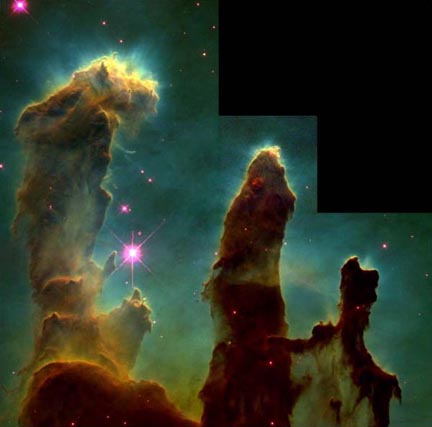
|
This part of the Eagle Nebula once looked like any other wispy cloudy nebula. But at some point in the past, new massive hot stars located above the frame of the photo started blazing away. They now send out intense ultraviolet radiation that sweeps away the gas and dust that makes up the nebula. It also heats up parts of the nebula enough to make them glow. Why did the pillars form? The head of each pillar contains exceptionally dense clots of gas and dust that represent baby stars in the process of formation. Their strong gravitational fields pull in the surrounding gas and dust and thus hold this material in place against the stellar winds. The parts of the nebula 'downwind' of the clusters of baby stars are shielded from the wind and thus form pillars. The baby stars need to reach a certain size before their centers attain the high temperatures and pressures needed to start up the nuclear fusion reactions that make a star a star. The baby stars in the heads of these columns are in a race against time: they have to suck in enough material to reach the right size before the rest of the surrounding gasses are blasted away. If they don't grow large enough, they won't become a proper star. The longest pillar is 1 light-year long (about 5.88 trillion miles, or about 800 times longer than the diameter of our Solar System). The clouds consist mostly of hydrogen with traces of other gasses and dust. The microscopic dust particles include graphite and certain rocks and minerals found on Earth. Next Image: Close up of the upper left-hand pillarImage credit: Hubble Space Telescope; The main source for HST images and explanations is HubbleSite.org. |
|
|
|
